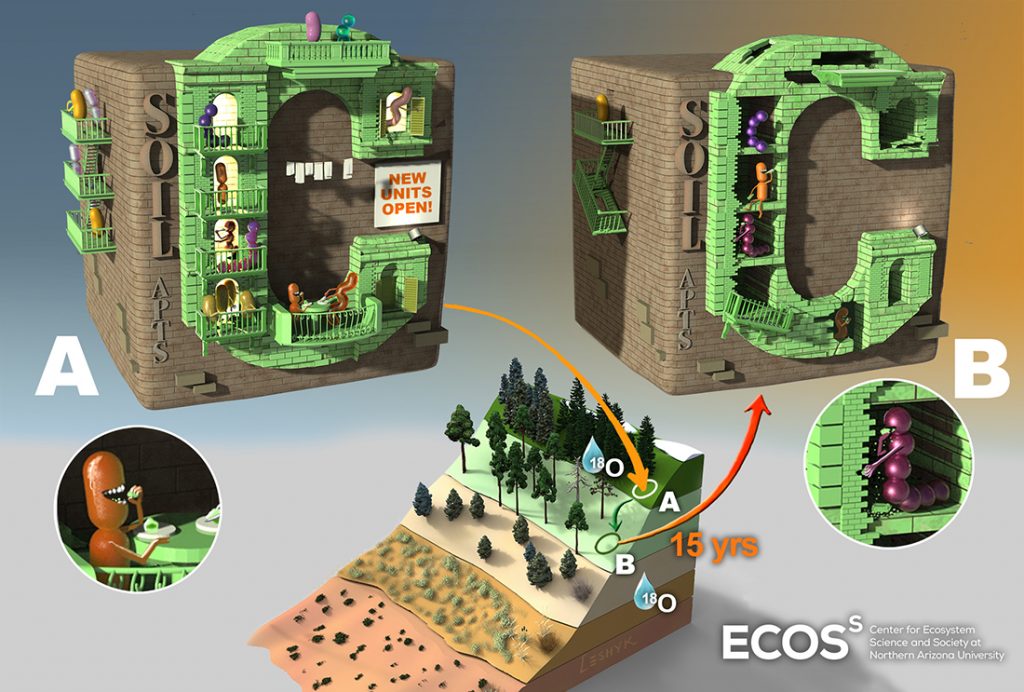In a first-of-its-kind warming experiment, researchers at Northern Arizona University found that microbes growth rate decreased over 15 years of warming. The research, published this week in Global Change Biology, showed that under warmer climate conditions, growth decreased among all types of microbes in the community, and suggested that a loss of soil carbon may be responsible for the slowdown.
In order to investigate the effect of warming on microbial communities, the team transplanted cylinders of soil from high-elevation forests north of Flagstaff to lower, warmer meadows to simulate climate warming, transplanting others at the highest elevation as controls. Over 15 years, the lower-elevation transplants were watered to match higher precipitation of their original climate, and researchers removed samples of the soil at regular intervals. Using quantitative stable isotope probing, or qSIP, a technique developed at NAU, the research team used water “labeled” with enriched oxygen to see which microbes incorporated the element into their DNA—a sign of growth.
“This study is the first to look at how individual microbial taxa respond to long-term warming in the wild,” said Alicia Purcell, the lead author of the study and a graduate student at the Center for Ecosystem Science and Society (Ecoss). “We were surprised to find very little variation in how the microbes responded to climate warming—growth slowed universally in this community.”
Purcell said the team also found that rare bacterial taxa were some of the fastest growers, underscoring the importance of detangling different organisms’ responses from one another.
These results offer an interesting counterpoint to short-term, laboratory-based warming experiments, which have shown that the growth of many microbes spikes under warmer conditions. Purcell’s team emphasized that a combination of factors, including plant productivity, nutrient cycling and loss of soil carbon are likely contributors to the warming effect they witnessed.
“Our results suggest that, in the case of warming, the community response tells us what we need to know,” said Bruce Hungate, senior author and director of Ecoss. “That’s really useful as we try to better model microbes’ complex contributions and responses to a changing climate. These results represent a new era, in which qSIP permits us to detect signals about what’s happening in soil without the noise that laboratory conditions introduce.”
Purcell was recently awarded a grant through the competitive Community Science Program of the Joint Genome Institute. The national award offers her technical support to process soil samples she collected in Antarctica two years ago as part of a different soil warming experiment. Based on the Marr Ice Piedmont Glacier on the West Antarctic Peninsula, Purcell, along with principal investigator Natasja van Gestel and graduate researcher Kellie McMillan of Texas Tech University, are asking how microbes, previously locked in ice and frozen ground in Antarctica, are behaving as the climate there warms.
Other NAU co-authors contributed to this study, including Michaela Hayer, Benjamin J. Koch, Rebecca L. Mau, Paul Dijkstra, Michelle C. Mack, Jane C. Marks, and Egbert Schwartz of Ecoss, as well as Steven J. Blazewicz and Jennifer Pett-Ridge of Lawrence Livermore National Laboratory, Ember Morrissey of West Virginia University and Rachel Rubin of Mount Holyoke College.
Graphic by Victor O. Leshyk, Ecoss
Kate Petersen | Center for Ecosystem Science and Society




